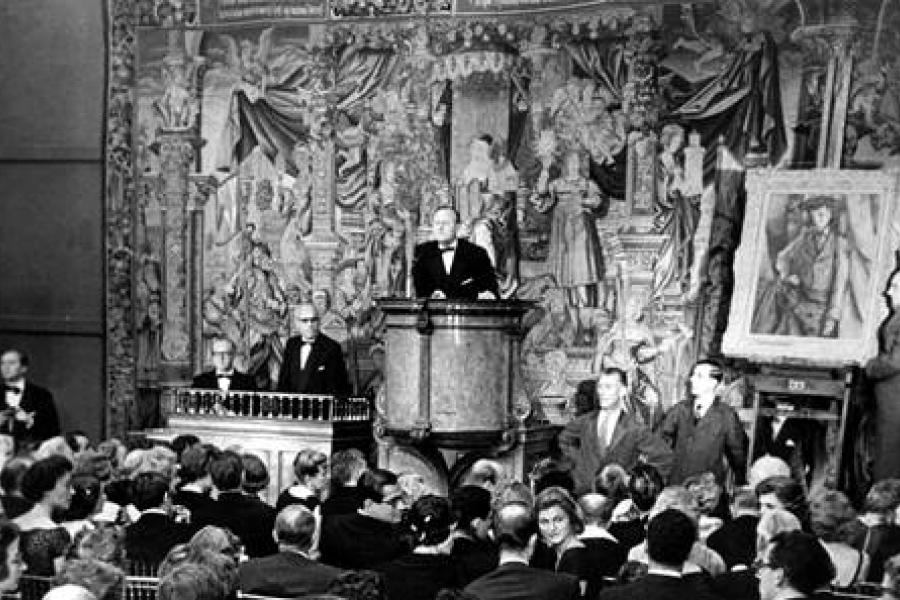Sotheby's Turns 275: London Exhibition Paints Colourful Picture of its History
 – “Sotheby’s as an Education”, the memories of writer Cyril Connolly, first published in 1961 - Mit freundlicher Genehmigung von: sothebys.com
– “Sotheby’s as an Education”, the memories of writer Cyril Connolly, first published in 1961 - Mit freundlicher Genehmigung von: sothebys.comWas: Auktion
Wann: 12.03.2019
On 11th March 1744, after a good decade of selling books from his corner table at the Angel and Crown pub in Covent Garden, Samuel Baker, a ‘joyous fellow’ with a love of books, an entrepreneurial spirit and a ‘fondness for plum-coloured coats’, did something different: he brought down the hammer on the first auction held in his own salerooms. That first sale of some ‘several hundred scarce and valuable books’ totaled the sum of £826. It marked the beginning of Sotheby’s and of a history punctuated with unexpected turns, colourful characters, nimble adaptation in the face of change and adversity, and much more besides.
The Exhibition:The 275th anniversary of Baker’s first auction has prompted Sotheby’s to shake out its archives and take a fresh look at that history, in the course of which, a fascinating cache of little-known memoirs and long-forgotten stories have been unearthed, along with rarely seen photographs and footage that together tell the story of Sotheby’s.
Much of the fruits of that research, including 67 photographs, will now be put on display in a lively, densely hung exhibition in Sotheby’s Café on Conduit Street in London, free and open to the public from March 11th till September 2019.
From the use of Sotheby’s picture basement as a public air raid shelter during the Second World War, to the entertaining accounts of the company’s first female employees, to spine-chilling ghost stories written by a staff member in a prisoner of war camp; from the lady who forgot to collect her Michelangelo to an Ian Fleming story set in Sotheby’s inspired the Bond film ‘Octopussy’; from hugely important discoveries to sales of some of the landmarks of our civilization, the exhibition will paint a colourful picture of the history of Sotheby’s, of the market with which it is entwined, while at the same time providing a fascinating chronicle of social changes over the ages.
Perhaps fittingly, given the company’s roots in the book world, a literary thread is never far from the surface. In 1823, following Napoleon’s death, Sotheby’s sold the books he had taken into exile to St Helena, the catalogue of which – also on display – reveals not only the French Emperor’s undying expansionist ambitions, but also the fact that ‘During his Captivity [in St Helena] Napoleon amused himself by making Critiques and Observations on Voltaire, Racine, Moliere, Corneille and other French dramatic authors’. The sale closed with the Emperor’s tortoiseshell-and-gold walking stick offered as the final lot.
Sotheby’s Today:Founded as an auctioneer of books – predating both the American and French Revolutions – the firm soon added fine art, house sales, jewelry, and more, and expanded from London to America, Asia, and beyond. Today, Sotheby’s has 80 offices in 40 countries and is the oldest company traded on the New York Stock Exchange (almost 50 years older than the Exchange itself) - where we will ring the Opening Bell this morning.
Sotheby's was the first auction house to set sail across the Atlantic and open offices in America (1955) and the first to hold auctions in Asia (1973). Sotheby’s pioneered the format of the evening “event” auctions that are a mainstay of today’s art market (1958), and were the first to use satellite transmission to allow for simultaneous bidding in London and New York (1960s). A Sotheby’s auction in the 1970s is credited with transforming the modern art market with the first auctions of works by living artists including Jasper Johns, Andy Warhol and Robert Rauschenberg, the first to sell a work for more than $100 million (2004), pioneers in the field of e-commerce (2000), and we recently brought scientific research (2017) and artificial intelligence (2018) in-house.
“Sotheby’s has thrived for 275 years precisely because it has dared to reinvent itself again and again, and in so doing has continually redefined the business of trading art on a global basis,” said Tad Smith, Sotheby’s CEO. “The company’s history is marked by a series of innovations that have not just continually changed Sotheby’s, but transformed the wider industry along with it. We are thrilled to share this important milestone with our clients, colleagues and shareholders around the world.”
Along the way, some of the world's most precious objects and collections have passed through Sotheby's: Napoleon’s Library (1823), the original manuscript for Alice’s Adventures Under Ground, presented by Lewis Carroll to the original Alice, Alice Liddell (1928), the 68-carat diamond bought by Richard Burton and Elizabeth Taylor (1969), Einstein’s Theory of Relativity (1987), The Jewels of the Duchess of Windsor (1987), The Andy Warhol Collection (1988), The Estate of Jacqueline Kennedy Onassis (1996), Sue the T Rex, now the star of the Field Museum in Chicago (1997), the collection of the Duke & Duchess of Windsor (1998), The Forbes Collection of Fabergé, including nine Fabergé Imperial Easter Eggs (2004), Martin Luther King’s Library (2006), The Magna Carta (2007), Edvard Munch’s ‘The Scream’ (2012), and property from the Collection of Mrs. Paul Mellon (2014).
Tags: Historische, Historische Dokumente.
Copyright © 2025 findART.cc - All rights reserved







